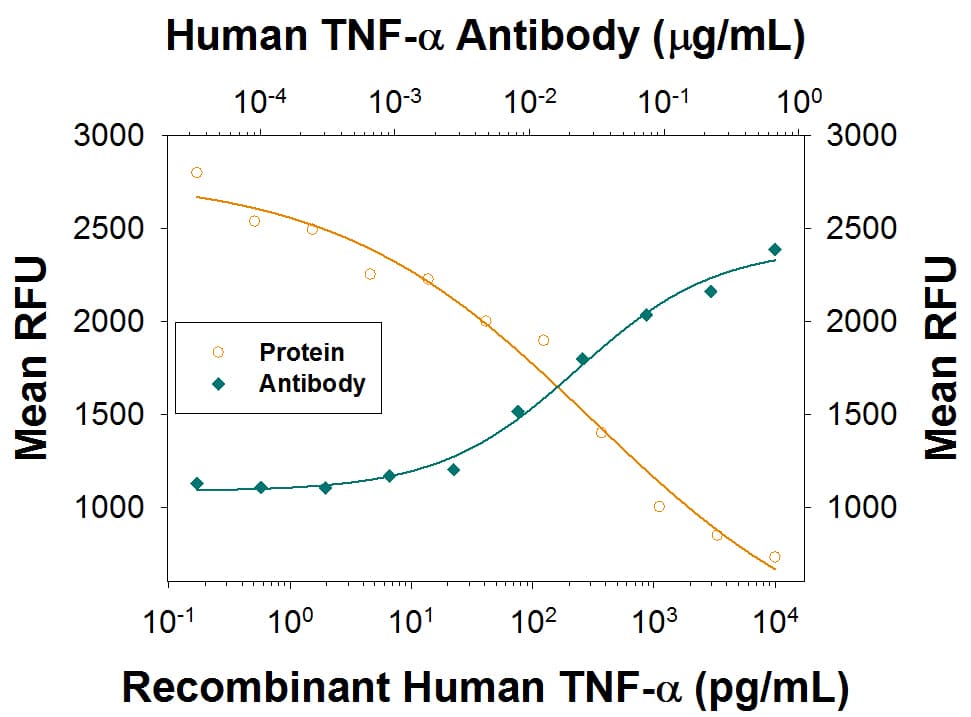 全部商品分类
全部商品分类

 下载产品说明书
下载产品说明书 下载SDS
下载SDS 用小程序,查商品更便捷
用小程序,查商品更便捷


 收藏
收藏
 对比
对比 咨询
咨询ELISA Detection (Matched Antibody Pair)(0.1-0.4 µg/mL )



Gly57-Leu233
Accession # P01375


Scientific Data
 View Larger
View LargerCytotoxicity Induced by TNF-alpha and Neutralization by Human TNF-alpha Antibody. Recombinant Human TNF-a (Catalog # 210-TA) induces cytotoxicity in the the L-929 mouse fibroblast cell line in a dose-dependent manner (orange line), as measured by Resazurin (Catalog # AR002). Cytotoxicity elicited by Recombinant Human TNF-a (0.25 ng/mL) is neutralized (green line) by increasing concentrations of Mouse Anti-Human TNF-a Recombinant Monoclonal Antibody (Catalog # MAB610R). The ND50 is typically 0.01-0.04 µg/mL in the presence of the metabolic inhibitor actinomycin D.
Human TNF-alpha Antibody Summary
Gly57-Leu233
Accession # P01375
Applications
Human TNF-alpha Sandwich Immunoassay
Please Note: Optimal dilutions should be determined by each laboratory for each application. General Protocols are available in the Technical Information section on our website.
ELISA Detection (Matched Antibody Pair)(0.1-0.4 µg/mL )


Background: TNF-alpha
Tumor necrosis factor alpha (TNF-alpha, TNF- alpha, TNFA ), also known as Cachectin and TNFSF2, is the prototypic ligand of the TNF superfamily. It is a pleiotropic molecule that plays a central role in inflammation, immune system development, apoptosis, and lipid metabolism. TNF- is produced by several lymphoid cells as well as by astrocytes, endothelial cells, and smooth muscle cells. Human TNF-alpha consisits of a 35 amino acid (aa) cytoplasmic domain, a 21 aa transmembrane segment, and a 177 aa extracellular domain (ECD). Within the ECD, human TNF-alpha shares 97% aa sequence identity with rhesus and 71%-92% with bovine, canine, cotton rat, equine, feline, mouse, porcine, and rat TNF-alpha. TNF-alpha is produced by a wide variety of immune, epithelial, endothelial, and tumor cells. TNF-alpha is assembled intracellularly to form a noncovalently linked homotrimer which is expressed on the cell surface. Cell surface TNF-alpha can induce the lysis of neighboring tumor cells and virus infected cells, and it can generate its own downstream cell signaling following ligation by soluble TNFR I. Shedding of membrane bound TNF-alpha by TACE/ADAM17 releases the bioactive cytokine, a 55 kDa molecular weight soluble trimer of the TNF-alpha extracellular domain. TNF-alpha binds the ubiquitous 55-60 kDa TNF RI and the hematopoietic cell-restricted 80 kDa TNF RII, both of which are also expressed as homotrimers present on virtually all cell types. Both type I and type II receptors bind TNF-alpha with comparable affinity, although only TNF RI contains a cytoplasmic death domain which triggers the activation of apoptosis. Soluble forms of both types of receptors are released and can neutralize the biological activity of TNF-alpha.

Preparation and Storage
- 12 months from date of receipt, -20 to -70 °C as supplied.
- 1 month, 2 to 8 °C under sterile conditions after reconstitution.
- 6 months, -20 to -70 °C under sterile conditions after reconstitution.
参考图片
Cytotoxicity Induced by TNF-alpha and Neutralization by Human TNF-alpha Antibody. Recombinant Human TNF-alpha (Catalog #
210-TA) induces cytotoxicity in the the L-929 mouse fibroblast cell line in a dose-dependent manner (orange line), as measured by Resazurin (Catalog # AR002). Cytotoxicity elicited by Recombinant Human TNF-alpha (0.75 ng/mL) is neutralized (green line) by increasing concentrations of Mouse Anti-Human TNF-alpha Recombinant Monoclonal Antibody (Catalog # MAB610R). The ND50 is typically
0.01-0.04 μg/mL in the presence of the metabolic inhibitor actinomycin D (1 μg/mL).




